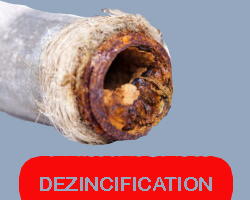Problems with Pex Plumbing
Complaints about early PEX water systems started when the fittings used to connect the pipes failed causing leaks. Manufactures improved their fittings which solved that problem and the popularity of PEX surged. Today, PEX is used in more than 60 percent of new construction residential water supply systems.
PEX plumbing system has been used for years and its failures has been well documented. Pex failures are linked to piping and fitting. Pex Piping fails when the pipes are exposed to chlorine that is common in municipal water supplies, exposure to direct sunlight before its installation. PEX pipe is also vulnerable when it contacts petroleum products or oxygen. Pex piping can leach toxic chemicals from pipe material. Pex compression fitting failure is caused by dezincification that results in corrosion which will create leaks.
In 1968, German scientist Thomas Engle discovered a way to crosslink common plastic (polyethylene) through radiation to produce a much suppler form of the material. The new plastic, fashioned into flexible PEX pipe (also known as PEX tubing), arrived in the US in the 1980s, initially for radiant floor heating systems: The flexible tubing is embedded in a concrete slab and hot water pumped through to heat the slab and radiate heat to rest of the room. PEX pipe remains popular for radiant floor heating.
Partial List of Manufactures with Problems
- PEX-A (Uponor/Wirsbo and Rehau): dezincification of fittings and chemical leaching/odor (AquaPEX only)
- PEX-B (Zurn & Viega): dezincification of fittings
- PEX-C (Nibco/CPI/DuraPEX): cracked, leaking pipes
- PEX-AL-PEX (Kitec/IPEX): dezincification of fittings
Dezincification
PEX pipes are made of plastic tubing that is connected by brass fittings. It has been alleged that these fittings contain a higher-than-normal level of zinc, which, when they come in contact with water, can fail earlier than expected due to a process known as “dezincification.” This can cause a range of problems, including leaks and flooding.
due to a process known as “dezincification.” This can cause a range of problems, including leaks and flooding.
“Fatigue” Failures
It is believed that some PEX tubing may be failing due to the amount of stress placed on the brass fittings connecting the tubes. When repetitive stress is put on the fittings, a hole or notch can develop and can eventually progress to a crack or fracture.
Benefits of Using Pex
- Installing PEX does not require soldering. Can be installed just using Crimp Tool
- PEX expands, making it more resistant to freeze-cracking
- PEX does not corrode
- Water flows silently through PEX, eliminating the “water hammer” noise associated with metal piping.
- Color-coding (red and blue) make it simple to distinguish hot and cold supply lines.
- PEX can be connected to existing plumbing with the correct fittings.
Disadvantages of Using Pex
- PEX is not suitable for outdoor use. Ultraviolet rays cause PEX to break down rapidly.
- PEX cannot currently be recycled.
- Though installation is DIY-friendly, fittings have to be correctly installed.
3 Types of Pex Plumbing
Type A Pex is manufactured using peroxide.
This type of PEX is the most flexible of the three types and is suitable for use in all home water-supply plumbing needs. It expands to the greatest degree when subjected to freezing water, so it’s the most resistant to cracking in frigid temperatures. It’s easy to work with but it’s more expensive than B or C.
Type B Pex is manufactured using moisture-cure method.
PEX-B is slightly stiffer than PEX-A, and has a distinct coil “memory” that makes the tubing want to return to its original coiled state. The coil memory, however, is not a hurdle to installation, and PEX-B is often the tubing of choice for residential plumbing because it also expands to resist cracking when water freezes but is less expensive than PEX-A: A 10-foot section of PEX-B runs $2.50 to $5.50, depending on brand and diameter. PEX-B also features an increased resistance to chlorine, making it a good choice in areas where water is highly chlorinated.
PEX-C is manufactured via an irradiation method.
Pex C is the stiffest version, PEX-C is the most difficult to work with; this stiffness also makes it liable to kink, as well as possible cracking if water freezes. These undesirable traits make PEX-C best suited for uses where bending is not required. PEX-C is the cheapest type.
Pex Connection Methods
Crimp rings are a band of metal, usually copper, that you slip over the fitting and compress with a crimp ring tool. The main problem is that you’ll need separate crimping tools for each size of pipe you are working with.
Cinch clamps work more like the traditional band clamps. You place the cinch tool over the protruding tab and squeeze to tighten the cinch clamp. The same tool works for all sizes of cinch clamps.